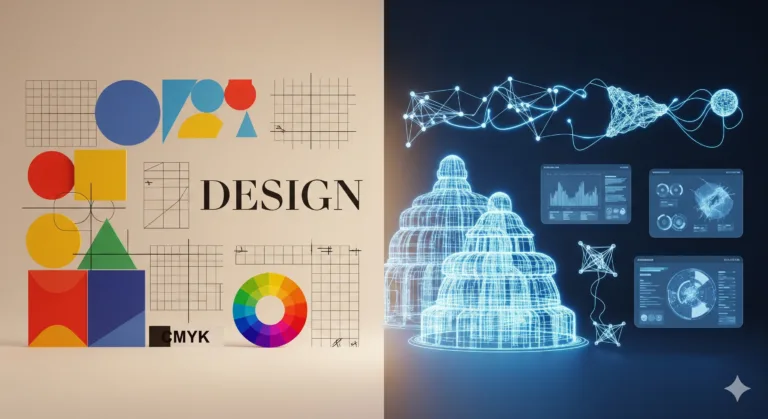Why Avoiding Design Mistakes is Fundamental?
Starting your design journey is exciting, but it can also feel overwhelming. You have ideas, enthusiasm, and a desire to create something visually appealing. However, sometimes the results don’t quite match the vision in your head. This can be frustrating and make you feel stuck.
The good news is that many common issues in beginner designs stem from a few identifiable mistakes. Understanding these pitfalls is the first step to overcoming them. By learning what these errors are and how to fix them, you can dramatically improve your work, build confidence, and move closer to creating the beautiful designs you envision.
Table of Contents
What Exactly are Design Mistakes?
In the world of design, a “mistake” isn’t necessarily a technical error. It’s more about choices that hinder the effectiveness, clarity, or aesthetic appeal of your work. For beginners, these often involve overlooking fundamental principles or making common missteps due to lack of experience or guidance.
Think of it like learning to bake. You might have the right ingredients, but if you use too much salt or bake at the wrong temperature, the final cake won’t turn out well. Similarly, in design, using clashing colors or too many fonts can make your project confusing or unpleasant to look at, even if you used the tools correctly.
The Essential Pillars of Good Beginner Design
Before diving into mistakes, let’s touch upon some core concepts that form the bedrock of strong design work, especially for those just starting out. Mastering these helps you avoid many common errors naturally.
- Visual Hierarchy: This is about guiding the viewer’s eye through your design, showing them what’s most important first. It’s like creating a clear path for information.
- White Space: Often misunderstood, white space (or negative space) is the empty area around elements. It’s crucial for readability, clarity, and giving your design room to breathe, making it feel less cluttered.
- Consistency: Keeping elements uniform throughout your project – like colors, fonts, and spacing – builds trust and makes your design look professional and cohesive.
- Color Harmony: Choosing colors that work well together creates a pleasant and effective visual experience. Understanding basic color theory helps you make intentional choices instead of random ones.
Mistakes That Can Ruin Your Design
Even with the best intentions, beginners often fall into common traps. Recognizing these is key to developing your skills. Here are five frequent errors and how to steer clear of them.
Ignoring these simple points can make your design look unprofessional or difficult for people to understand. But don’t worry, they are easy to correct once you know what to look for.
- Overcrowding Your Layout
Problem description: Trying to cram too much information or too many elements into a small space. This makes the design look busy, messy, and overwhelming, making it hard for the viewer to know where to look or what the main message is.
Solution: Embrace white space! Give your elements room. Prioritize content and remove anything non-essential. Use hierarchy to guide the eye and group related items together. - Using Too Many Fonts (Or Wrong Ones)
Problem description: Selecting a multitude of different typefaces for a single project, or choosing fonts that are hard to read or don’t match the project’s tone. This creates a chaotic look and undermines readability.
Solution: Stick to a maximum of two or three font families. Choose fonts that are legible at various sizes and that fit the overall mood of your design. Pair contrasting but complementary fonts (like a serif and a sans-serif) for visual interest. - Lack of Visual Consistency
Problem description: Inconsistent use of colors, fonts, spacing, image styles, or element placement across different parts of a design or project. This makes the work look amateurish and disjointed.
Solution: Create a simple style guide for your project. Define your color palette, font choices, spacing rules, and how elements like buttons or headings should look. Apply these rules uniformly throughout your design. - Poor Color Combinations
Problem description: Using colors that clash, have insufficient contrast (especially between text and background), or don’t convey the right mood or message for the project. This can make the design visually unpleasant or inaccessible.
Solution: Learn basic color theory, including concepts like complementary and analogous colors. Use online tools to help create harmonious palettes. Always check for sufficient contrast, especially for text, to ensure readability for everyone. - Not Establishing Clear Hierarchy
Problem description: Presenting all information as equally important, making it difficult for the viewer to quickly grasp the main point or navigate the content. Important elements don’t stand out.
Solution: Use size, weight (boldness), color, and placement to differentiate elements. Make headlines larger than body text, use bold for key phrases, and place the most important information in a prominent position. Guide the viewer’s eye from the most important to the least important elements.
Step by Step: Applying Good Design Practices to Your Projects
Avoiding mistakes is easier when you have a simple process to follow. Here’s a straightforward approach you can use for your next design project to help you sidestep common beginner errors.
Following these steps will help you build a solid foundation and make more intentional design choices from the start, leading to better outcomes.
- Step 1 – Plan Your Layout and Hierarchy: Before adding elements, sketch out or plan where everything will go. Identify the most important piece of information and decide how you will make it stand out. Think about the flow – how should someone’s eye move through your design?
- Step 2 – Choose Your Color Palette: Select your main colors early based on the project’s purpose and mood. Aim for a limited palette (3-5 colors is often a good start). Consider color harmony and contrast, especially for text.
- Step 3 – Select and Pair Your Fonts: Pick your typefaces, ideally limiting yourself to two or three. Ensure they are readable and suitable for the project. Define which font will be used for headings, body text, and any other elements.
- Step 4 – Build and Refine with White Space: Start placing your elements according to your layout plan. Actively use white space to separate sections and make your design breathe. Don’t be afraid of empty areas; they are essential for clarity.
- Step 5 – Check for Consistency and Contrast: Review your design to ensure you’ve used your chosen colors, fonts, and spacing consistently. Double-check that text has enough contrast against its background to be easily read by everyone.
- Step 6 – Get Feedback: Share your design with others, ideally experienced designers if possible. Ask for constructive criticism, specifically mentioning the areas you focused on (like readability, hierarchy, or color use). Be open to suggestions.
Frequently Asked Questions about Design Mistakes
It’s natural to have questions as you learn. Here are some common ones beginners ask about avoiding design errors.
Getting clarity on these points can help you make better decisions and feel more confident as you design.
Q: How many fonts should I use in one design?
A: For most beginner projects, sticking to two or three font families is a good rule of thumb to maintain visual harmony and avoid a cluttered look.
Q: What exactly is white space and why is it important?
A: White space is the empty area in your design. It’s vital because it improves readability, helps separate elements, reduces clutter, and gives your design a clean, professional appearance.
Q: How do I know if my colors clash or have enough contrast?
A: Learning basic color theory helps you choose harmonious colors. For contrast, especially text, use online contrast checker tools to ensure your design is accessible and easy to read.
Conclusion: Avoiding Mistakes in Practice
Every designer makes mistakes, especially when starting out. The key isn’t to never make an error, but to learn to recognize and correct them. By being aware of these five common pitfalls – overcrowding, poor typography, inconsistency, bad colors, and lack of hierarchy – you can approach your projects more thoughtfully.
Focus on applying the fundamental principles we discussed. Practice makes perfect, and with each project, you’ll get better at spotting potential issues and making choices that result in clear, effective, and beautiful designs. Keep experimenting, keep learning, and don’t be afraid to iterate based on feedback.
Deepen your knowledge by reading our article about Fundamental Design Principles!



